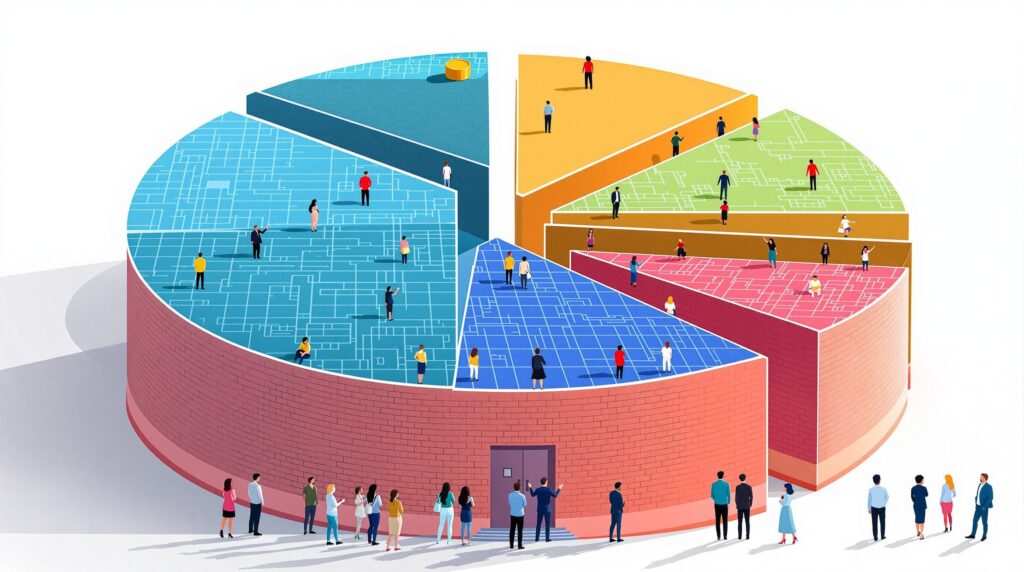[rev_slider alias=”slider-1″][/rev_slider]
Introduction to Layer 1 Blockchains
Have you ever wondered what lies at the core of the cryptocurrency world? The answer often points to Layer 1 blockchains. These foundational layers play a critical role in the cryptocurrency ecosystem, serving as the main highway for transactions and smart contracts. Understanding Layer 1 blockchains is like understanding the foundation of a skyscraper—without it, nothing else can stand tall.
What is a Layer 1 Blockchain? A Layer 1 blockchain is the base layer of a blockchain network, responsible for the core transactions and smart contract operations directly on the main chain.
Layer 1 blockchains, such as Bitcoin and Ethereum, operate the primary network and facilitate decentralized transactions and communications across various nodes. They provide a secure environment where data integrity is maintained through cryptographic methods and consensus algorithms like Proof of Work and Proof of Stake.
Architecture and Functionality
So how does it all work? The architecture of a Layer 1 blockchain employs a decentralized ledger that ensures transparency and immutability. Every transaction is recorded across all participating nodes, leaving no room for discrepancies. Let’s break down the primary components:
- Decentralized Ledger: Maintains a shared record of all transactions across the network.
- Consensus Mechanism: Ensures that all nodes agree on a single version of truth.
- Smart Contracts: Self-executing contracts with the terms of the agreement directly written into lines of code.
- Cryptographic Security: Protects the blockchain data with advanced cryptography.
This architecture supports blockchain innovation by providing a reliable and transparent foundation for developing complex decentralized applications (dApps) and solutions.
Layer 1 vs Layer 2 Solutions
The blockchain ecosystem doesn’t stop at Layer 1. Enter Layer 2 solutions—a separate framework built on top of the Layer 1 blockchain to enhance its capabilities. These solutions address scalability issues by improving transaction speeds and reducing network congestion.
- Layer 1: The foundational blockchain that handles essential operations.
- Layer 2: Enhances functionality by offering scalability improvements.
- Interoperability: Allows different blockchains to communicate, enabling cross-chain operations.
With Jara’s proprietary Layer 2 blockchain solution based on Caldera, there’s a unique opportunity to experience benefits like low fees, fast transactions, and secure platforms optimized for real-world asset tokenization. As Africa’s digital transformation surges forward, Layer 1 and Layer 2 solutions work in tandem to fuel the continent’s financial revolution.
Why It Matters
Layer 1 blockchains aren’t just a technological masterpiece—they’re a gateway to the future of finance and digital assets. They connect global capital to African assets with platforms like Jara, enabling economic empowerment and financial inclusion. Understanding these foundational systems prepares us for the innovative opportunities they bring to the table.
The emerging era of digital finance relies on frameworks like Layer 1 blockchains to pave the way for inclusive and transparent financial systems.
As you explore the layers of blockchain technology, ponder this: How will these innovations ignite change across Africa’s financial landscape? As digital assets and blockchain technology evolve, Jara remains at the forefront, supporting a new era of opportunities.
Cross-Chain Interoperability: The Future of Blockchain
In the dynamic landscape of blockchain technology, cross-chain interoperability is rapidly emerging as a key enabler for seamless data and asset transfers among different blockchain networks. Are you wondering why this matters? Well, imagine trying to send money without the ability to communicate between banks—cross-chain interoperability addresses a similar issue but within the blockchain ecosystem.
Layer 1 blockchains, often referred to as the foundational layer, play a significant role in fostering this interoperability. They provide the infrastructure needed for different blockchain protocols to coexist and interact efficiently. So, how do these Layer 1 blockchains enable this seamless integration?
What is Layer 1 Blockchain? A Layer 1 blockchain is the base layer of a blockchain network, responsible for all on-chain transactions, typically providing the primary layer of data storage and smart contract execution.
Layer 1 solutions such as Ethereum and Bitcoin are vital because they support the execution of dApps and the transfer of tokens between chains through mechanisms like atomic swaps and protocol bridges. These mechanisms create channels where data can flow freely and securely, reducing the need for centralized exchanges that may pose security risks.
- Atomic Swaps: These empower users to trade tokens directly from their digital wallets across different blockchains without relying on a centralized platform.
- Protocol Bridges: Designed to connect blockchains, allowing assets and data to be transferred swiftly and safely between networks.
Interoperability also facilitates a robust digital economy by enabling blockchain applications to interact across different ecosystems. This opens a door to endless possibilities—think about decentralized finance (DeFi) applications accessing liquidity from multiple networks, which can unlock innovative financial solutions like asset tokenization, a major thrust of $JARA in Africa.
Explore legal defenses for bitcoin fraud
Layer 1 blockchains establish interoperability standards, forming a crucial component of the Jara ecosystem. The proprietary Layer 2 blockchain developed by Jara, based on Caldera architecture, offers reduced transaction fees and fast processing speeds, propelling Africa’s digital asset economy towards the future.
“Invest in $JARA today to be part of Africa’s digital transformation, harnessing the power of innovative blockchain technology to drive financial inclusion.”
With the backing of leading capital partners like Mechanism Capital and Digital Point72, Jara is not only setting the stage for cross-chain transactions but also facilitating access to previously inaccessible investment opportunities, like the $6 billion Lagos airport tokenization project.
The future of blockchain lies in its ability to connect varied systems seamlessly, much like connecting diverse financial institutions on a global scale. This symbiotic relationship enhances the overall value and utility of digital currencies and assets. By empowering cross-chain interoperability, Layer 1 blockchains are not just influencing the current state of blockchain technology—they’re shaping its destiny. As these connections grow stronger, the possibilities they unlock expand exponentially, placing Africa—and $JARA—at the forefront of this exciting innovation wave.
[rev_slider alias=”text-call-cta”][/rev_slider]
Comparing Layer 1 and Layer 2 Blockchain Solutions
In the dynamic world of blockchain technology, understanding the distinct functionalities and advantages of Layer 1 and Layer 2 solutions is crucial for anyone looking to invest in or utilize these systems effectively. These layers play complementary roles, each contributing to the overall efficiency and scalability of blockchain networks.
Layer 1 Solutions: The Foundation of the Blockchain
What are Layer 1 blockchains? Layer 1 blockchains refer to the base layer of the blockchain architecture. These are the ground layer protocols like Bitcoin and Ethereum. They comprise the foundational framework where transactions are processed, validated, and added to the distributed ledger.
- Key Features: Layer 1 solutions provide the fundamental security and decentralization essential for blockchain integrity. This layer is responsible for consensus mechanisms such as Proof of Work (PoW) or Proof of Stake (PoS). For instance, Ethereum 2.0’s transition to PoS improves energy efficiency and scalability.
- Notable Examples: Bitcoin’s Lightning Network and Ethereum’s base layer. These represent large, well-known solutions that provide stability and security within blockchain networks.
Nevertheless, Layer 1 blockchains face issues with scalability. As blockchain platforms grow, they encounter limitations in processing speeds and transaction throughput. This is where Layer 2 solutions come in, offering innovative ways to address these limitations.
What is Layer 1 Blockchain? A Layer 1 blockchain is the foundational layer, responsible for the security and decentralized structure of a blockchain system, processing and validating all transactions on the main network.
Layer 2 Solutions: Enhancing Efficiency and Scalability
Layer 2 blockchain solutions operate on top of Layer 1 protocols, designed to tackle scalability issues without compromising on security or decentralization. They step in to provide the much-needed speed and efficiency for the expanding needs of blockchain platforms.
- Scalability Solutions: These include off-chain solutions such as sidechains and state channels, designed to handle transactions off the main chain, thus reducing congestion and enhancing throughput.
- Technological Advancements: Technologies like Rollups and Plasma chains are becoming integral. Rollups, for example, bundle multiple transactions into a single one, reducing the computational load on the main chain.
By relieving the main chain of excess transactional data, Layer 2 allows the network to handle a higher volume of operations. This augmentation demonstrates how essential Layer 2 solutions are in addressing the inherent limitations of the foundational layer.
What is Layer 2 Blockchain? Layer 2 blockchains are secondary frameworks built on top of Layer 1 networks, enhancing scalability and transaction throughput by processing operations off the primary blockchain.
The Synergy Between Layer 1 and Layer 2
The interplay between Layer 1 and Layer 2 solutions is crucial for maximizing the efficiencies of blockchain technology. These solutions are not independent; rather they are designed to complement each other’s strengths and compensate for each other’s weaknesses.
- Synergistic Relationship: Layer 1 ensures security and decentralization, while Layer 2 optimizes for speed and scalability. Together, they create a robust ecosystem able to handle increasing demand.
- Real-World Examples: Ethereum’s integration with solutions like Optimism or Arbitrum, which enhance transaction speeds and lower costs, epitomizes this synergy. Such integrations have made Ethereum more accessible and economically viable.
This dual-layer approach allows blockchain platforms to maintain their decentralized ethos while adapting to ever-growing demands. It highlights the necessity of advanced solutions in mainstream technology adoption.
How do Layer 1 and Layer 2 solutions interact? Layer 1 ensures a secure, decentralized base, while Layer 2 drives scalability, making the blockchain ecosystem more efficient and user-friendly.
Conclusion
While the worlds of Layer 1 and Layer 2 blockchain solutions might seem complex, understanding their distinct and complementary roles is pivotal for anyone involved in blockchain technology or investments. By leveraging the strengths of both layers, networks can achieve unprecedented scalability, security, and decentralization, driving the future of blockchain innovation.
Impact of Interoperability on Global Finance
Transforming Financial Infrastructure
Have you ever wondered how the financial world could change if different blockchains could seamlessly communicate with each other? Cross-chain interoperability, fostered by Layer 1 blockchains, is set to revolutionize global finance by enabling this very communication. Imagine a world where digital assets move quickly and efficiently across borders, languages, and systems. This innovative change is not just a prediction—it’s a reality in the making.
Let’s delve into how these breakthroughs are reshaping the financial infrastructure globally:
- Democratizing Access: Cross-chain interoperability allows individuals and businesses worldwide to access digital assets without being constrained by local financial systems. By leveraging Layer 1 blockchains, platforms like Jara are bridging the divide, bringing investments in African assets to a global audience and redefining economic boundaries.
- Reducing Barriers: One of the significant hurdles in today’s financial systems is the plethora of barriers that exist for trading and transferring assets globally. Through interoperability, these barriers are minimized, promoting a more fluid and accessible financial market.
- Enhancing Security and Trust: By utilizing sophisticated blockchain technology, cross-chain interoperability offers a high level of security and trust. Transactions between chains are authenticated and verified on both ends, ensuring safe interactions.
By breaking down these barriers, cross-chain interoperability is not only transforming financial infrastructure but also democratizing financial opportunities. But what does this mean for individuals and businesses, particularly in Africa?
Opportunities for Africa’s Financial Inclusion
The African continent, rich with untapped potential, stands to gain immensely from these technological advancements. Financial inclusion has long been a challenge due to inadequate infrastructure and restrictive systems. However, platforms like Jara are capturing this moment to provide an inclusive ecosystem powered by the Jara app.
How does cross-chain interoperability democratize finance? By enabling seamless exchanges between different cryptocurrencies and digital assets, it reduces restrictive barriers to entry, thus fostering economic inclusion.
With these tools, Jara provides users with access to tokenized real-world assets, which were previously out of reach for many. This move is not just about enabling transactions; it’s about empowering people to participate actively in the digital economy. By making financial services accessible to more people, particularly on a continent like Africa, the potential for economic growth is monumental.
As cross-chain interoperability continues to evolve, it reshapes the landscape of global finance, unlocking unprecedented growth opportunities. It’s not merely a technological novelty; it’s a fundamental change in how the financial world operates, inviting everyone to be part of this transformative journey.
[rev_slider alias=”schedule-consultation-btn”][/rev_slider]

How do Layer 1 blockchains facilitate cross-chain interoperability?
Answer: Layer 1 blockchains achieve cross-chain interoperability by implementing bridges and protocols that allow different blockchain networks to communicate and transfer data or assets. This is primarily done by establishing a standardized protocol that each blockchain must adhere to, ensuring seamless interaction and compatibility.
What is the role of smart contracts in cross-chain interoperability?
Answer: Smart contracts play a pivotal role in cross-chain interoperability by automating and enforcing the rules of asset transfers between different blockchains. They ensure that transactions are executed only when predefined conditions are met, providing security and reducing the need for intermediaries.
Why is cross-chain interoperability important for decentralized finance (DeFi)?
Answer: Cross-chain interoperability is crucial for DeFi as it allows for the free flow of tokens and assets across different blockchain networks, enhancing liquidity and creating a more interconnected financial system. This interoperability enables users to access a broader range of financial services and products across platforms.
Can Layer 1 blockchains improve the scalability of blockchain networks?
Answer: Layer 1 blockchains can enhance scalability by improving the underlying technology, such as consensus mechanisms and data structures, to handle higher transaction volumes more efficiently. This scalability is essential for supporting the growth and adoption of blockchain applications globally.

Introduction to Layer 1 Blockchains
Understanding the foundational role of Layer 1 blockchains in the cryptocurrency ecosystem. Explore the architecture and functionality that support blockchain innovation.
Cross-Chain Interoperability: The Future of Blockchain
Dive into how Layer 1 blockchains foster cross-chain interoperability, enabling seamless data and asset transfer between different blockchain networks.
Comparing Layer 1 and Layer 2 Blockchain Solutions
Examine the differences and complementary roles of Layer 1 and Layer 2 solutions, highlighting technological advancements and efficiencies.
Impact of Interoperability on Global Finance
Transforming Financial Infrastructure
Analyze the significant impact cross-chain interoperability will have on global financial systems, particularly in democratizing access to digital assets.
Related Practice Areas
Explore additional topics and pages related to Layer 1 blockchains and their role in cross-chain interoperability, expanding your understanding of the blockchain landscape.
Hear From Our Satisfied Clients
Our commitment to excellence in Layer 1 and Layer 2 blockchain solutions is evident in every case we undertake. The positive feedback from our clients is a testament to the hard work and dedication we consistently deliver.

[rev_slider alias=”slider-3″][/rev_slider]
[rev_slider alias=”slider-6″][/rev_slider]
Connect with Jara: Transform Your Blockchain Experience
Ready to explore the endless possibilities that Layer 1 blockchains and cross-chain interoperability can offer? Connect with Jara today and empower your blockchain ventures with seamless connectivity and innovation. Our expertise in Layer 1 and Layer 2 solutions ensures that you gain access to cutting-edge technology tailored to your needs.
“Your Voice, Our Mission” – at Jara, we bridge global capital to African assets with the tenacity and dedication that has earned us the trust of our community members.
Awards and Recognitions
- Named among the “Top Blockchain Innovators 2023” by Global Blockchain Awards, recognizing our groundbreaking contributions to blockchain technology.
- Highlighted as one of the “Leading Digital Transformation Solutions 2023” by Digital Tech Insights for our effective implementation of cross-chain interoperability.
- Listed in “Best Fintech Ideas of 2023” by FinTech Trends, applauding our unique approach to merging global capital with African markets.
- Awarded “Excellence in Blockchain Solutions 2023” by Technology Awards Organization, highlighting our leadership in blockchain implementation.
- Recognized among the “Top Innovators in Financial Infrastructure 2023” by Financial Global for revolutionizing financial systems with advanced blockchain solutions.
Don’t just take our word for it – see for yourself how Jara is transforming the landscape of digital assets. Download the Jara app today!
Download the Jara App
For more information, visit our website at www.getjara.xyz or email us at [email protected].
Chinyere “Chi” Nnadi Bio
Founder and CEO, Jara | Blockchain Technology Specialist
Content Reviewed by Chi Nnadi and his Content Team. Chi is an experienced entrepreneur dedicated to transforming Africa’s financial ecosystem through blockchain technology. As Founder and CEO of Jara, he builds enterprise-grade infrastructure converting illiquid African assets into globally accessible digital tokens. With his proprietary Layer-2 blockchain technology, Chi bridges the gap between global investors and Africa’s growing digital asset market.
Our Content Review Process
Chi Nnadi along with Jara’s dedicated content team, pledge to offer top-notch material. Our content guidelines ensure thoroughness, reputable sources, unbiased scrutiny, among other quality metrics. Please let us know if there is anything you believe to be inaccurate.
















